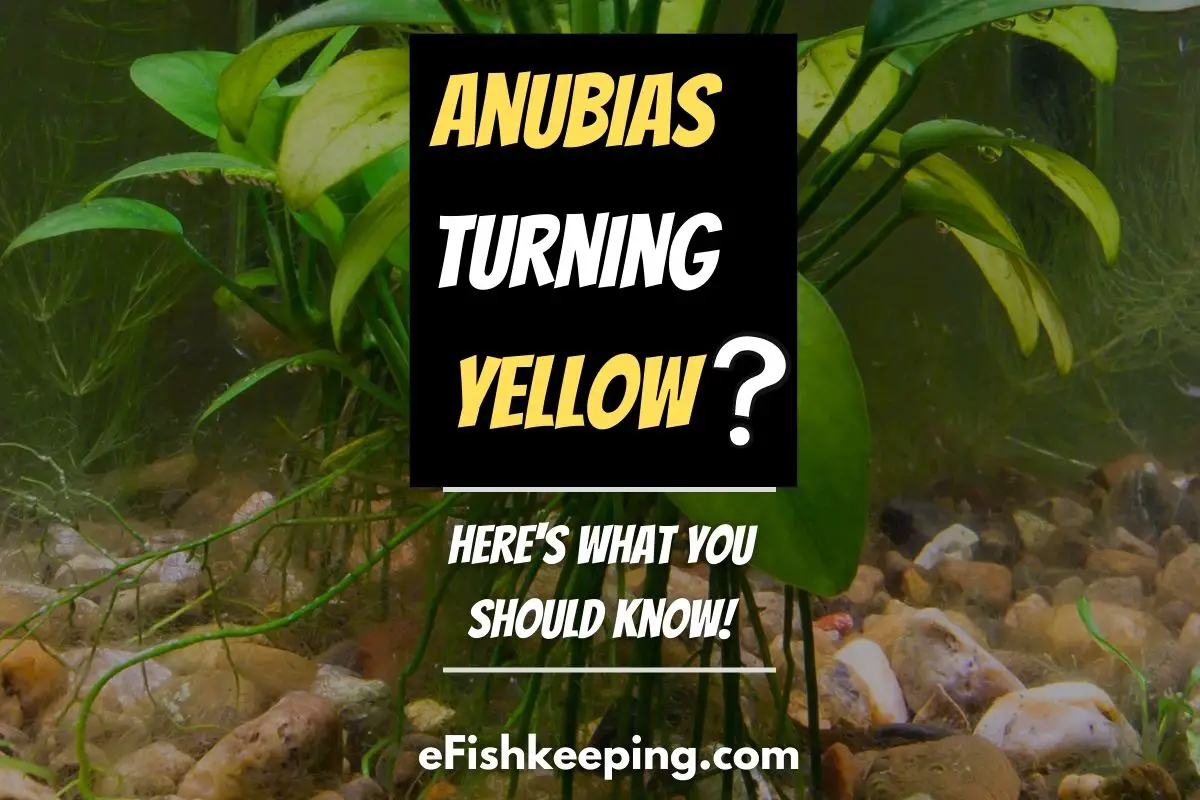Maintaining plants can be difficult in and of itself, but when you’re adding live plants into an aquarium, there is a whole new set of skills you need to learn.
Anubias make lovely ornamental plants for your aquarium, but if you notice your Anubias turning yellow, what are you supposed to do?
Anubias tend to turn yellow due to improper growing conditions of some sort. This could potentially be because of the way it’s planted.
Furthermore, Anubias turning yellow can be because certain aspects of the aquarium need to be adjusted. Unfortunately, some plants will just start to rot, and there isn’t much you can do to prevent it.
Don’t allow your yellowing Anubias to disrupt the look of your aquarium – or worse, disrupt your fish’s happiness – by knowing if you can cure your Anubias, or if it’s time to replace them.
Below are a few reasons that your Anubias could start yellowing, as well as a few solutions that could help revive your plant before it dies.
Pro-Tip: One of the best ways to ensure your Anubias stay healthy and don’t develop discoloration issues is by adding right fertilizer. I recommend checking out this best quality fertilizer for Anubias (available on Amazon).
Why Are My Anubias Turning Yellow?
Determining exactly what is causing your Anubias to yellow can take some experience.
If you’re new to aquarium plants, it’s worth knowing the potential causes so you can fiddle around with your plant and aquarium conditions to determine the root cause.
#1. Anubia Rot
Anubia rot is a common occurrence, and it has been difficult to determine why exactly it happens.
One of the surefire signs of Anubia rot are discolored leaves, which will often be yellow or black. Furthermore, the leaves tend to become more gel-like, and will eventually start to melt away.
Anubia rot may also be the cause of your yellowing plant if you notice the leaves fall off of the rhizome shortly after they start to turn yellow.
When you go to pick up these fallen leaves, you’ll also notice they feel like jelly.
Furthermore, when you touch the rhizome, you’ll notice it feels a lot less firm than it is supposed to.
The unfortunate thing is that, because there is no definitive cause of Anubia rot, you can’t necessarily prevent it in a particular fashion.
Instead, you can try to keep your water as clean as possible while also feeding your Anubias well and pruning them occasionally.
#2. Anubia Isn’t Planted Well
When you’re installing the Anubia into your aquarium, you need to be sure that the rhizome of the plant has the freedom to grow around the hardscape and implant its roots into it. (If you’re not sure what the rhizome is, it’s the thick part of the plant’s stem.)
You should also make sure your hardscape is secured well to the aquarium.
How you do this is up to you; you can have it set between other aquarium plants or decorations, or use water-safe gel or glue to fasten it to the bottom of the aquarium.
#3. Anubia Is Still Adapting
If you have just recently planted your Anubia into your aquarium, you need to give it a couple of weeks to adjust to its new environment.
Anubias are not grown in water before you bring them home and put them into your aquarium. Thus, the current leaves of the plant have adapted to living above water.
When you move your plant from above water to below water, it’s going to need a couple of weeks to adapt to living in a new environment. Through this process, it’s normal for older leaves to yellow and die to make room for new leaves that will be able to thrive in the water.
Keep your eye on the plant and prune each week or so, and you’ll notice the plant adapts within a few weeks.
Read: How Long Your Anubias Can Be Out Of Water?
#4. The Lighting Is Off
Like most plants, Anubias need adequate light in order to grow. With Anubias, they don’t need extremely bright or constant lights, but they do need a source of low light in order to grow.
They grow slow on their own, and without adequate light, they will barely grow and may just start to yellow and die.
Still Curious? For more information read our guide: How Much Light Does Anubias Need?
#5. The Water’s Nutrients Are Poor
For many plants, including Anubias, they will develop yellow spotting when they are lacking nutrients.
A lack of iron is usually the main cause of yellowing leaves. Adding some iron into the water should do the trick.
#6. The Water Is Dirty
Maintaining a clean aquarium is one of the most important parts of keeping aquatic plants and fish alive.
A dirty tank can not only make your fish sick, but it can cause your plants to build up bacteria and potential infections. This can become a vicious cycle of water infecting plants, then plants infecting water, and so on.
Most of these plant diseases, such as microbes, can’t be cured once they develop, so your best course of action is to prevent them from happening in the first place by frequently testing your water levels and replacing your dirty water with clean water.
#7. Your Plant Might Be Dying
Sadly, no matter how diligent you are with plant maintenance, every plant’s life must come to an end. When your plant is getting older, it’ll have a harder time absorbing nutrients. One sign of aging is yellowing and discoloration within the leaves.
How Do I Cure My Anubias That Are Turning Yellow?
You don’t want to become immediately discouraged if your Anubias are starting to yellow. It’s not a surefire indication that your plant is on its last legs. There are a few solutions that could help reduce the spread of any potential rot, as well as ways to adjust its environment to encourage healthier growth.
Since the condition of your aquarium plants contribute to the overall environment and quality of water in your aquarium, dealing with the issue as soon as you notice it is key.
The last thing you want is a sick plant making your fish sick.
#1. Change The Hardscape
If your Anubias are just free-floating in your aquarium, they aren’t going to grow properly.
You should have your plant attached to some type of hardscape that will help keep it in place. As mentioned, the rhizome of the Anubia needs to be secured well to the hardscape, while also having room to spread out.
You want to be sure that when you’re tying your plant to the hardscape, the rhizome is exposed towards the top of the aquarium because that part of the plant needs to be able to absorb the light from your light source.
You may be able to fix this by simply adjusting the position of your plant towards the light source.
#2. Change Your Fertilizer
You should be adding fertilizer to your aquatic plants occasionally to make sure they have the proper nutrients to thrive.
An inadequate fertilizer could be causing your Anubias to become discolored.
Make sure your fertilizer has a good source of iron and magnesium; if it doesn’t, it’s time to make a switch.
Additionally, a lack of calcium and nitrogen can also cause your leaves to become discolored.
#3. Test The Water
The water conditions may not be ideal for your Anubias to thrive. This might be caused by changing your water too often or not enough. Finding that balance can be tricky, but it’ll come with experience.
You want to make sure that, when you’re changing your water, you aren’t adding new water that is much warmer or much cooler than usual. You want to keep the temperature pretty steady, as these changes can impact your plants’ health and your fish’s health.
Yellowing leaves are a good indication that the water might be too cold for your Anubias.
#4. Cut The Yellow Parts Off
If you suspect your Anubias are turning yellow due to rot, there isn’t any type of treatment available that has been proven to remove the rot.
Instead, the only option you really have is to cut off any of the yellowing or rotting parts to allow the plant the option to regrow itself and reduce the spread of infection.
#5. Adjust Your Lighting
As mentioned, Anubias need light. The amount of light should be fairly low but existent. If your light is too high or way too low, they aren’t going to grow well and the leaves will start to yellow and die.
You also want to make sure you have enough lighting to be dispersed throughout the area of your tank.
If you have an especially large aquarium, you might need more than one light source so that everything in your tank that needs light gets enough.
I also recommend reading our related guide: Do Fish Tank Light Need To Be On All The Time?
Conclusion
There are a few reasons that your Anubias are turning yellow, but thankfully, there are ways to either prevent yellowing or fix it before it’s too late.
It takes some trial and error to be able to properly diagnose a yellowing Anubia, but it’s worth the effort to keep these plants thriving for as long as possible.
Anubias that have the proper conditions to grow can make for a beautiful addition to your aquarium, and also offers a solution for solitude and rest for your fish.
Recommended Reading:
- Top 23 Things You Should Know About How Amazon Swords Reproduce
- Why Are Anubias So Expensive? [Reasons + Cheap Alternatives]
Hi! I’m Praveen Ghoshal, the founder of eFishkeeping.com. Inspired by my Dad, I got interested in fishkeeping when I was a kid. Since then, I have been involved with this hobby. Currently, I have 3 fish tanks at our home, and I enjoy this hobby with my full family. Read more about me here.







![Why Are Anubias So Expensive? [Reasons + Cheap Alternatives] why-are-anubias-so-expensive](https://efishkeeping.com/wp-content/uploads/2022/12/anubias-in-a-planted-aquarium-300x200.jpg)

